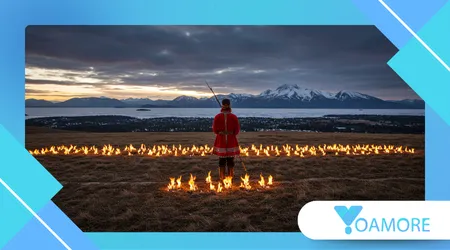The Sámi Languages: Fighting for Survival Above the Arctic Circle

Few cultural legacies in Europe carry as much resilience and vulnerability as the Sámi Languages.
Anúncios
Spoken for centuries above the Arctic Circle by the Sámi people of Norway, Sweden, Finland, and Russia, these Uralic languages embody an entire worldview tied to nature, tradition, and ancestral memory.
Their existence, however, is increasingly threatened.
More Than Just Words: Why Language Matters
The Sámi Languages are more than means of communication; they are carriers of history, spiritual traditions, and deep ecological knowledge.
Language, in this context, is inseparable from the land and life it describes. To speak Sámi is to speak the Arctic.
Anúncios
The vocabulary in these languages reflects a unique relationship with the environment. North Sámi, for instance, contains more than 180 terms for snow and ice conditions.
This linguistic richness supports not only cultural preservation but also reindeer herding, hunting, and fishing practices.
Still, fewer than 30,000 people speak any of the ten known Sámi languages today. Many dialects, such as Ter Sámi, are on the brink of extinction.
According to UNESCO, Ter Sámi had fewer than 10 fluent speakers in 2024. That isn’t just a linguistic loss—it’s the collapse of a generational bridge.
Also read: Can Superstitions Impact Mental Health? Cultural Perspectives
The Roots of Suppression
The decline of the Sámi Languages is no accident. Historical suppression began in the late 1800s, when governments across the Nordic region launched assimilation policies.
Sámi children were placed in boarding schools where speaking their language led to punishment.
These “Norwegianization,” “Swedification,” and similar efforts effectively disconnected generations from their native tongues.
This trauma still echoes today. The 2022 Truth and Reconciliation Commission in Norway revealed that many older Sámi individuals still avoid speaking their language in public due to shame imposed during childhood.
While official apologies have been made, real reparation requires investment in linguistic and cultural revival. Symbolic gestures don’t rebuild languages—policies and resources do.
+ The Mystery of Kusunda: A Language Isolate with No Known Relatives
Learning to Speak Again: The Role of Education
One of the key pillars of any language revitalization is education. Across Sápmi, initiatives to integrate Sámi language instruction in schools have gained momentum.
Bilingual kindergartens and immersion programs are growing, particularly in northern Norway and Finland.
However, disparities remain. According to a 2023 report from the University of Tromsø, fewer than 40% of Sámi children in Norway have access to comprehensive language instruction.
The problem is twofold: a lack of fluent teachers and a lack of political will to scale programs.
Many young people grow up hearing their grandparents speak Sámi but are never taught it themselves.
The emotional barrier that results is not easily overcome—they often feel the language belongs to the past, not their future.
+ The Last Whistlers: The Whistled Language of La Gomera
Technology and the New Frontier of Resistance

In the age of digital communication, tech is proving to be both a challenge and a tool for revival.
While mainstream platforms are dominated by global languages, Sámi content creators are carving out their own spaces.
Young Sámi influencers now post content in North and Inari Sámi on TikTok, YouTube, and Instagram.
Language-learning apps like “Oahpa!” and “Sápmi Language Keyboard” are making digital literacy more inclusive. Video games are being localized in North Sámi, creating immersive experiences for youth.
Even OpenAI has begun to explore how AI can be adapted to support underrepresented languages, although large-scale efforts for Sámi remain in early stages.
Access to high-speed internet in rural Sámi communities, however, remains inconsistent—a barrier that must be addressed.
Legal Recognition Across Borders: A Fragmented Effort
While the Sámi Languages are recognized in Norway, Sweden, and Finland, levels of protection and support vary widely.
Norway leads in linguistic policy, with the Sámi Act ensuring the right to use Sámi in public services.
Sweden’s support is more limited, and Russia’s policies are often seen as neglectful or obstructive.
On the Kola Peninsula, Ter and Kildin Sámi suffer from lack of state support and absence of media or educational content.
The challenge lies in transnational coordination. The Sámi Council, a cross-border body, advocates for unified policies, but governments still operate in silos.
Legal status must translate into meaningful action—from access to public services in Sámi to media production, teacher training, and funding mechanisms.
A Generation Reclaiming Voice
Despite historical trauma, today’s Sámi youth are not silent. They are hosting podcasts, composing songs, and writing poetry in their native tongues.
In Finland, Inari Sámi artist Petra Laiti has become a cultural leader through activism and music that integrates Sámi language with modern beats.
One example from the Sámi Education Institute in Inari involves storytelling circles, where elders and teenagers co-create stories using traditional Sámi structures.
This participatory approach isn’t just educational—it’s transformative. It rebuilds trust between generations and repositions the language as a living tool.
A student from the project once said, “Speaking Sámi doesn’t make me feel small. It makes me feel like I exist in a wider story.”
| Sámi Language | Approximate Speakers | UNESCO Status | Primary Regions |
|---|---|---|---|
| North Sámi | ~20,000 | Vulnerable | Norway, Sweden, Finland |
| Inari Sámi | ~400 | Severely Endangered | Finland |
| Skolt Sámi | ~300 | Severely Endangered | Finland, Russia |
| Ter Sámi | <10 | Critically Endangered | Russia (Kola Peninsula) |
Political Will and Sustainable Funding
Efforts to preserve the Sámi Languages often face financial uncertainty. Short-term grants dominate the landscape, making it difficult to establish stable infrastructure.
According to the Nordic Council’s 2023 language report, less than 0.03% of Norway’s education budget is allocated to Sámi instruction.
This financial inconsistency jeopardizes progress. Language learning isn’t a sprint; it’s a lifelong process that demands long-term investment.
From hiring teachers to developing textbooks and funding media, every link in the chain matters.
One practical suggestion? Establish language endowments managed by Sámi communities themselves, supported by government contributions and private donors.
Empowerment must start with trust and autonomy.
Global Solidarity and Cultural Justice
The loss of a language is the loss of an ecosystem of thought. But unlike natural disasters, this kind of extinction is preventable.
Supporting the Sámi Languages is about more than preservation—it is an ethical stance.
In 2022, UNESCO launched the International Decade of Indigenous Languages, highlighting the need for global support structures.
The Sámi struggle aligns with those of the Ainu in Japan, the Mapuche in Chile, and hundreds of other indigenous groups worldwide.
To learn more about these efforts, visit UNESCO’s Indigenous Languages Hub.
Governments, NGOs, and tech companies must work together to reverse the centuries of silencing. Solidarity cannot be performative; it must be structural.
Identity Is Not Disposable
To understand why the Sámi Languages matter, consider this: language is not just something people speak—it’s something they feel.
Losing it is like losing the ability to pray in your own voice or laugh in your mother’s tongue.
A language carries family, humor, pain, and place. Rebuilding a broken linguistic bridge is painstaking, but every reclaimed syllable is a seed of dignity.
When Sámi youth write music in their native tongue, they are not reviving the past—they are reshaping the future.
If you want to explore one of the most innovative programs currently fostering indigenous language learning, visit Giellatekno at the University of Tromsø.
Frequently Asked Questions (FAQs)
1. How many Sámi languages are there?
There are ten known Sámi languages, though only a few have active speaker communities today. North Sámi is the most widely spoken.
2. Are all Sámi languages mutually intelligible?
No. Some, like North and South Sámi, are distinct enough to be considered separate languages rather than dialects.
3. Can I learn a Sámi language online?
Yes. Platforms like Oahpa! and Giellatekno offer resources for learners at different levels.
4. Is Sámi taught in public schools?
In Norway and Finland, some schools offer bilingual education, but access is limited and varies by region.
5. How can I support Sámi language preservation?
Support Sámi-owned initiatives, advocate for inclusive education, and promote visibility through media and public discourse.
The fight to preserve the Sámi Languages is not a nostalgic endeavor; it is a declaration of presence, pride, and purpose. Let it be heard.
